| Author | Message | ||
| George Martinez (Foohorse)
Registered Member Username: Foohorse Post Number: 180 Registered: 1-2010 Posted From: 72.144.22.70 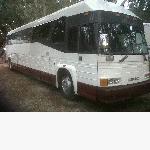 Rating: N/A |
Has anyone used this or similar products? as a heat barrier for the roof. http://www.hytechsales.com/ | ||
| Gus Causbie (Gusc)
Registered Member Username: Gusc Post Number: 1198 Registered: 11-2005 Posted From: 173.202.40.167  Rating: N/A |
Yes, a whole bunch of stuff is in the archives either here or at the "other" forum, don't remember which. | ||
| Jim Wallin (Powderseeker01)
Registered Member Username: Powderseeker01 Post Number: 83 Registered: 10-2008 Posted From: 76.76.66.103  Rating: N/A |
Works as advertised. Best to buy the beads and mix your own. Use good paint like Benjamin Moore. | ||
| Jerry W Campbell (Jerry_w_campbell)
Registered Member Username: Jerry_w_campbell Post Number: 37 Registered: 7-2005 Posted From: 206.125.83.12 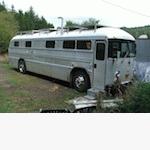 Rating: N/A |
Yes, I use the stuff. I have 2 coats of BusKote on my ceiling and 5 coats on the roof. I does make a noticeable difference in temperature. I have used it for 6 years. BusKote is a flat paint and as a result collects dust. You need the clear coat to be able to scrub it clean when needed. Jerry | ||
| FAST FRED (Fast_fred)
Registered Member Username: Fast_fred Post Number: 1256 Registered: 10-2006 Posted From: 99.153.142.249  Rating: |
Any insulation is valued on its thickness , and the thickness of this majic is? White on white is probably the best , easiest to keep clean (and therefore cool). Toplac a boat paint by International is one part and really easy to get a good looking job. FF | ||
| Jerry W Campbell (Jerry_w_campbell)
Registered Member Username: Jerry_w_campbell Post Number: 38 Registered: 7-2005 Posted From: 206.125.83.176  Rating: N/A |
"Any insulation is valued on its thickness , and the thickness of this majic is?" They say 2 coats. I don't remember how many mils thick that is. Here's what they say about R Value. "R-values are measured by testing laboratories who use, ASTM (American Society of Testing and Materials) procedures. Existing test procedures require that the sample submitted be 1" thick therefore paints and coatings cannot be tested using established test methods. Tests have been performed on 1" thick materials with a known R value and then compared with the same material coated with insulating ceramic reinforced paints and the difference between the two is equal to an average of 35% reduction of heat transfer." Jerry | ||
| Jack Fids (Jack_fids)
Registered Member Username: Jack_fids Post Number: 118 Registered: 1-2009 Posted From: 69.171.160.236 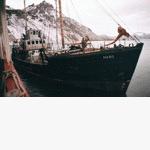 Rating: N/A |
I had the exhaust manifolds ceramic powdercoated on my 4106, it is a silver color, those manifolds are now so cool that after a 500 mile run I could grab them with a bare hand when I went back to do an oil level check. I also do some collector car restoration for a few clients who own cars that have a particular engine heat problem (esp. in AZ), I recommend ceramic coating the exhaust systems on those vehicles as well. Recall the ceramic blocks that cover the belly of the Space Shuttle they can be heated to glowing red hot and still be held by the corners with bare fingers? SAME STUFF. Never have used the "mix it yourself" stuff ....but I don't see why it won't work to lower the temps. of anything on the opposite side of the coating. The thicker it is the greater the barrier .....ladle it on like you were Tammy Faye Baker's make-up "artist" and stay cool! If you are looking for a buisness that does this work Google "Jet Hot Coatings"....their main facility is in Texas. I get my work done in Chicago even tho there is a Phoenix business that does it too. FWIW..... the tops of Pistons & combustion chambers along with Valve faces are commonly ceramic coated in racing engines along with the exhaust systems..... the hotter the exhaust gasses are, the FASTER they will flow out the end of the pipe... more HP for very little investment.... plus that back room in your coach will be cooler as well! ( Geo. I know you want to do your exterior & this is of little use to you but to those who have no experience with ceramics this serves to fill that void in a miniscule way) | ||
| Kyle Brandt (Kyle4501)
Registered Member Username: Kyle4501 Post Number: 595 Registered: 9-2004 Posted From: 65.23.106.193 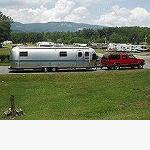 Rating: N/A |
conduction, convection, & radiant Those are the 3 methods of heat transfer. Solar heating is radiant. heating by air is convection. Heating by direct contact is conduction. The R values are for conduction. If I am correct, the ceramic beads & coatings work by reducing the radiant heat transfer - simple test is to paint half of the test surface black & the other white. Take temperature readings when placed in the sun on both sides of the different colors. Then see how things change when placed in the shade with hot air being blown against one side. (I remember seeing test results that showed the ceramic bead coating rendered ineffective when the roof got black from being parked under trees. I don't remember any of the other details, so it doesn't mean much now.) The thing we are all looking for is better control of the heat gain/ loss in our living area. Insulation isn't cheap, so we need to choose what works best for our individual situation. | ||
| George Martinez (Foohorse)
Registered Member Username: Foohorse Post Number: 182 Registered: 1-2010 Posted From: 72.144.22.70  Rating: N/A |
kyle thank you for that, so you are saying that the coating will work against radiant heat (sun beating the roof) but not that well for convection, If the air out side is 90 this wont help as well as say foam on the inside. I don't mind doing both. I also do intend to have as much of the space on the roof covered by solar panels I will be close to doing this process and all the help is appreciated. Jack F your post are a help, I forgot that the manifolds being coated would help. I do not really want to take them of yet until the need arises. so instead in the interim I am thinking of using an insulating wrap. for the manifolds on down. Fred my plan is for a white bus with a navy blue accent color stripe. simple and along the lines of boats, after all a bus is a land yacht of sorts and in Florida that colour scheme is very practical as well. my interior I envision a nautical theme also akin to 40s 50s era feadship. I don't want to remove the interior to correct problems because of skimping on insulation. Thank you all for the information thus far | ||
| FAST FRED (Fast_fred)
Registered Member Username: Fast_fred Post Number: 1257 Registered: 10-2006 Posted From: 99.153.142.249  Rating: N/A |
Recall the ceramic blocks that cover the belly of the Space Shuttle The shuttle tiles work by ablation. The heat is so intense that the solid tile surface first liquifies and then vaporises. This requires the heat of liquification (like ice melting)and evaporation which is a pretty high number for silivon tiles. Even in Texas , I'm not sure it gets this warm. Our experience with the ceramic bubble powder in paint was a disaster. The surface resembled fine (200-400_ sandpaper and was a dirt magnet. Remember rain is nor pure , it has a speck of dirt in every drop "Condensation nuclei", each ois deposited on the roof , in FL its a great quantity. Weekly scrubbing would have been a solution , but... FF | ||
| Kyle Brandt (Kyle4501)
Registered Member Username: Kyle4501 Post Number: 597 Registered: 9-2004 Posted From: 65.23.106.193  Rating: N/A |
RE: the shuttle tiles - They are several inches thick too. The difference in thickness makes a big difference when comparing insulation properties. And another thing - the shuttle tiles are't constructed with the ceramic paint beads . . . Something else which means comparing the two is like comparing fiberglass insulation with single pane glass - sure, both are made of the same basic material, but the method of manufacture & construction is hugely different. You'd really need to handle the shuttle tile to understand how unique it is. As a side note, did you know that there is a critical thickness for pipe insulation? As the outside surface area increases, so do the losses from convection . . . . | ||
| steve wardwell (Steve_wardwell)
Registered Member Username: Steve_wardwell Post Number: 60 Registered: 2-2010 Posted From: 75.202.174.230 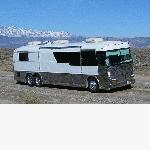 Rating: N/A |
Sounds like about $10 a gallon for the additive. My roof is white and applied by a roller. I've been using a 3 part epoxy with lots of clear in it to hold up against the FL. sun with "good" although not excellent results. Washing a coach roof I see as a fact of clean living, not fun perhaps but a chore to be done every three months or more if parked under dirty trees. I will add this stuff to the paint next round of roof coating, probably this winter down south. To me this sounds like it's worthwhile. | ||
| steve wardwell (Steve_wardwell)
Registered Member Username: Steve_wardwell Post Number: 61 Registered: 2-2010 Posted From: 75.202.174.230  Rating: N/A |
Ps for me more texture or nonskid on the roof is a good thing.I've added nonskid to boatdecks for years. (Message edited by steve_wardwell on July 29, 2010) | ||
| Bruce Henderson (Oonrahnjay)
Registered Member Username: Oonrahnjay Post Number: 575 Registered: 8-2004 Posted From: 68.33.63.79  Rating: N/A |
FF and others, has anyone tried this stuff with the "clear coat" on it? I agree that it probably won't do much good but if it does any good (and it's not really difficult to take care of/ if the clear coat makes it OK to keep clean), it may be worthwhile. I'm interested in as much insulation as possible. | ||
| Jerry W Campbell (Jerry_w_campbell)
Registered Member Username: Jerry_w_campbell Post Number: 39 Registered: 7-2005 Posted From: 206.125.82.49  Rating: N/A |
If you do not put on a clear coat you will not like it. Take my word for it. It is a VERY flat paint. It will collect EVERYTHING and won't last more than a few months before it's way too dirty to clean. The clear coat makes cleaning possible and it will last for years. Jerry | ||
| Jim and Myrna Lawrence (Daffycanuck)
Registered Member Username: Daffycanuck Post Number: 71 Registered: 10-2004 Posted From: 66.82.9.55 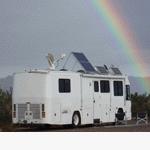 Rating: N/A |
Our coating 'temp coat' was applied on the inside, prior to finishing... http://lawrj.sasktelwebsite.net/interior.htm | ||
| FAST FRED (Fast_fred)
Registered Member Username: Fast_fred Post Number: 1259 Registered: 10-2006 Posted From: 99.153.142.249  Rating: N/A |
"I'm interested in as much insulation as possible" Someone used to sell a booklet in re insulating the roof from the outside. 6 inches ? of good foam laid on the stock roof was covered with a thin aluminum cover. That's! insulation !! , not .003 of "miracle" dust paint. FF | ||
| Bruce Henderson (Oonrahnjay)
Registered Member Username: Oonrahnjay Post Number: 576 Registered: 8-2004 Posted From: 68.33.63.79  Rating: N/A |
"6 inches ? of good foam laid on the stock roof" Yeah, which runs into one of my issues. I'm already 13'6". I do have some cavity between the roof in upstairs ceiling but I am kind of hoping that a little heat rejection will take some of the load off that. But I agree that a few thous of "miracle stuff" isn't likely to do a lot of good. | ||
| Kyle Brandt (Kyle4501)
Registered Member Username: Kyle4501 Post Number: 599 Registered: 9-2004 Posted From: 65.23.106.193  Rating: N/A |
Look at what MCI did for the 5's that were sent to Saudi Arbia - a second roof that created a ~1.5" air gap. Heat shields work well at blocking radiant heat transfer. Magic & miracles have their place tho. . .  | ||
| steve wardwell (Steve_wardwell)
Registered Member Username: Steve_wardwell Post Number: 63 Registered: 2-2010 Posted From: 75.200.172.143  Rating: N/A |
A little Off topic but..I've been trying to dream up a way to have my ACs under a "tent' for shade.maybe like flex poles spanning gutter to gutter and open-ended or multiples.But can't get past the BUTT UGLY factor...I would just like to hear my AC's sigh.....anyone Ideas ? (Message edited by steve_wardwell on July 30, 2010) | ||
| Kyle Brandt (Kyle4501)
Registered Member Username: Kyle4501 Post Number: 600 Registered: 9-2004 Posted From: 65.23.106.193  Rating: N/A |
Split system Basement air roof deck TRAVELERS (not Farmers) insurance (Message edited by kyle4501 on July 30, 2010) | ||
| Jim Wilke (Jim Bob) (Pd41044039)
Registered Member Username: Pd41044039 Post Number: 536 Registered: 2-2001 Posted From: 184.0.3.170 Rating: N/A |
Farmer's Insurance???? | ||
| Kyle Brandt (Kyle4501)
Registered Member Username: Kyle4501 Post Number: 601 Registered: 9-2004 Posted From: 65.23.106.193  Rating: N/A |
Oops, sorry for the confusion. Thanks for catching that for me Jim. I meant Travelers insurance - the one with the big red umbrella that covers & protects those in distress.  | ||
| Gus Causbie (Gusc)
Registered Member Username: Gusc Post Number: 1200 Registered: 11-2005 Posted From: 173.202.41.167  Rating: N/A |
Direct sunlight is by far the greatest source of heat in our metal buses, especially the Al ones. Once you stop this with ceramic or anything else, even simple white paint, the rest is easy. I have no problem cooling my 4104 with a white vinyl roof anytime it is out of the direct sun. Even a slightly cloudy day makes a great difference. I'm also giving serious thought to a ceramic coated roof but I doubt it will stick to the vinyl. I hate the thought of having to remove that stuff. | ||
| Bruce Henderson (Oonrahnjay)
Registered Member Username: Oonrahnjay Post Number: 577 Registered: 8-2004 Posted From: 68.33.63.79  Rating: N/A |
Gus, while I take FF's point that a paint coating isn't really going to "insulate" anything, do you think that the ceramic paint will result in significant heat rejection; i.e. less heat coming in for insulation to deal with, and less than a plain white paint? | ||
| steve wardwell (Steve_wardwell)
Registered Member Username: Steve_wardwell Post Number: 64 Registered: 2-2010 Posted From: 75.203.102.164  Rating: N/A |
If it makes an exhaust manifold cool enough to touch I'll try it.Can't hurt. | ||
| les marston (Les_marston)
Registered Member Username: Les_marston Post Number: 91 Registered: 1-2010 Posted From: 68.151.225.213 Rating: N/A |
Steve How soon do you plan on trying this paint? Please don't forget to let us know how it works out Les | ||
| steve wardwell (Steve_wardwell)
Registered Member Username: Steve_wardwell Post Number: 65 Registered: 2-2010 Posted From: 75.203.102.164  Rating: N/A |
I'll wait until We get to south FL. for a round of roof paint. Here in NC. I'm under some Oak or some such that stains badly IF we don't get enough rain to wash the roof and car.I cover the white car for protection.My white 3 part epoxy is 3 years old and just starting to lose some of its gloss and it has a lot of texture already so I'll wash well, wipe with acetone and use my epoxy 2 coats with additive.Mid November-December for the painting same timing for my radiator core job. | ||
| Jerry W Campbell (Jerry_w_campbell)
Registered Member Username: Jerry_w_campbell Post Number: 40 Registered: 7-2005 Posted From: 206.125.87.50  Rating: N/A |
A couple of thoughts about ceramic powder. As fred said if you mix the powder with thinner paint such as automotive paints it will have a surface about like 200 grit sand paper. If you happen to scrape a knuckle on it it will take meat off. I have painted the sides of my bus with it and it does not seem to get any dirtier the any other paint. If you paint the roof with it I would imagine it would catch everything that fell out of the sky and you would have to clean it often. The rubber (elastometric) paint like BusKote is VERY VERY White and VERY thick and is a great sealer. You can't even see the powder at all. With a clear coat it has a nice smooth surface and is easy to clean. Jerry | ||
| steve wardwell (Steve_wardwell)
Registered Member Username: Steve_wardwell Post Number: 67 Registered: 2-2010 Posted From: 75.203.102.164  Rating: N/A |
I have used a thich rubbery type of roof coating from the home cheapo can't recall exactly what it was.Maybe kool Roof ??? on my other bus (buffalo) ... although very white it needed re coating every 2 years was subject to extreme mildew and washed away in the rain marking the sides of the coach and windows..very UNsatisfactory | ||
| Bruce Henderson (Oonrahnjay)
Registered Member Username: Oonrahnjay Post Number: 579 Registered: 8-2004 Posted From: 68.33.63.79  Rating: N/A |
Jerry, In your experience, does the BusKote (with ceramic particles and clear coat) mildew and wash away in the rain, marking the sides of the coach and windows, as Steve's experience with the other coating? (Message edited by oonrahnjay on July 31, 2010) | ||
| Gus Causbie (Gusc)
Registered Member Username: Gusc Post Number: 1201 Registered: 11-2005 Posted From: 173.202.0.63  Rating: N/A |
Bruce, My impression is that ceramics reflect heat more than insulate, especially on roofs. By reflecting heat it is blocking it. I stand to be corrected on that, however. This is what white paint does on the roof and it is very effective. Simple proof is-place your hand on the horizontal surface of a white car in direct sunlight on a hot summer day and the other hand on a dark one, especially black. Be prepared to remove the hand on the dark one very quickly! I think the same thing happens on exhaust manifolds, the heat is reflected back into the exhaust and is forced on out through the exh pipes. If what I think is true that means the other bus insulation is left with less work to do. | ||
| FAST FRED (Fast_fred)
Registered Member Username: Fast_fred Post Number: 1264 Registered: 10-2006 Posted From: 99.153.142.249  Rating: N/A |
While the roof is the prime receiver of the suns rays , the sides are a huge surface too. Awnings or trees aren't much help on the road , but white inside the windows IS. Tinted glass absorbes heat , and radiates it into the coach , perhaps the mirrored coating stuff outside would help ? In summer camping we open the engine compartment while hooking up in a campground. A ton of HOT! cooles off better , so the rear bed area is easier to cool naturally. FF | ||
| Buswarrior (Buswarrior)
Registered Member Username: Buswarrior Post Number: 1892 Registered: 12-2000 Posted From: 174.91.140.11  Rating: N/A |
I second the "open the engine doors on arrival" strategy. Every degree you get flushed out the doors is one less to soak into the underside of the bed, which is already heat saturated by the drive. happy coaching! buswarrior | ||
| Jerry W Campbell (Jerry_w_campbell)
Registered Member Username: Jerry_w_campbell Post Number: 41 Registered: 7-2005 Posted From: 206.125.91.118  Rating: N/A |
"Jerry, In your experience, does the BusKote (with ceramic particles and clear coat) mildew and wash away in the rain, marking the sides of the coach and windows, as Steve's experience with the other coating?" If you do not have a clear coat, that's exactly what happens. The clear coat is a part of the process. As Fred says, there are many other factors involved in keeping the bus from getting hot inside. reflective window coverings in the sunny windows, keep your awning on the south side, open the right windows, exhaust fans, insulation, etc,etc. Jerry | ||
| clint hunter (Truthhunter)
Registered Member Username: Truthhunter Post Number: 631 Registered: 1-2009 Posted From: 24.129.238.13 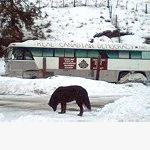 Rating: N/A |
...from all the application I found real test data on 6 years back, it would be most effective applied inside between you coach roof & the insulation, as beads mixed into what ever you wished for bonding, perhaps even with foam paint, assuming your striping the inside roof out. -Roof top applications & durability/cost effectiveness is questionable , as many have sited above. ~how can one small dog be expected to drive a bus, you better allow her to find a driving mate to operate those pedals amigo. Beside then you would not know whom to blame for the dog miss duties, helps us grow in all kind of ways we would otherwise avoid growing, not unlike obesity kind of growth, only more cuddly. | ||
| George Martinez (Foohorse)
Registered Member Username: Foohorse Post Number: 185 Registered: 1-2010 Posted From: 72.144.61.73  Rating: N/A |
uh... duh... what?. He is saying something about driving a bus not a Hummer, so shut up and hit the gas harder. | ||
| Gus Causbie (Gusc)
Registered Member Username: Gusc Post Number: 1202 Registered: 11-2005 Posted From: 173.202.24.236  Rating: N/A |
We do open the engine door but must be very careful so that nobody walks into the corners. Since we use WM parking lots a lot we have to be extra careful. I thought about silver or white on the windows but it looks like h... so decided against it. | ||
| Buswarrior (Buswarrior)
Registered Member Username: Buswarrior Post Number: 1894 Registered: 12-2000 Posted From: 174.91.144.79  Rating: N/A |
A few traffic cones, or a more creative looking obstruction, can come in handy for the busnut. A traffic cone at each front bumper corner forces you to walk a little wider, then not whacking your noggin on a mirror. When setting up camp for longer, two potted plants will do the same job. Same for the engine doors, or whatever else you put in the way of your head/body as as an early warning sign you are getting forgetful.... happy coaching! buswarrior | ||
| Bill 340 (Bill_340)
Registered Member Username: Bill_340 Post Number: 112 Registered: 7-2006 Posted From: 75.202.7.116 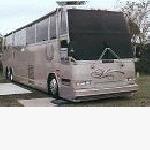 Rating: N/A |
I am not a rocket scientist like some of you all, NO OFFENSE MEANT.. But we used ceramic paint on our eagle a few years ago and it kept the roof inside from being hot, Had no xtra insulation in that one.BUT I can say from a layman or poormans point of veiw, we took a piece of thin galvanizes metal, about 1 1/2 in wide and 4 in long, painted one end of the metal strip on both sides with the ceramic paint. when dried we held the painted side in our hands and applied a propane torch to the other end, till it was cherry red, the painted end was slightly warm while an inch or so away was GLOWING RED, NowI dont know what the r ,insulation rating or whatever is, or do I even care, THIS WAS AN ACTUAL TEST, all the theories and books can take a bow, It worked for us and many others and if I get time I will do my H also. Came from a company In Inverness fl, on the south side of town Rt 41 I think, Astec coatings I think. They MAKE it there, Hope this helps someone, and dosent agravate too many others, OH yea I think the co name was Industrial coating corp. The mans name that explanied this all to us was Bill De Carlo.maybe he is still there, Been 6 or more years, | ||
| Jack Fids (Jack_fids)
Registered Member Username: Jack_fids Post Number: 122 Registered: 1-2009 Posted From: 69.171.160.26  Rating: N/A |
"Recall the ceramic blocks that cover the belly of the Space Shuttle The shuttle tiles work by ablation. The heat is so intense that the solid tile surface first liquifies and then vaporises. " Ever watch a Shuttle return from space? Ever notice that the Ceramic tiles that were on it when it launched are STILL there on arrival (minus those whacked by space junk )? The WHITE X-15 of 1967 used an ablative skin...but three is little or no reference to "Ablatives" in recent times. IF you go here - http://www.gizmag.com/spray-on-ceramic-coating-dramatically-reduces-external-temperatures/ 6642/ you will read this: A high-technology ceramic coating originally developed for the nuclear industry and already used by Formula One teams is now available for automotive applications. Applied to the exhaust manifold using a high-temperature plasma spray, the Zircotec coating greatly reduces the release of heat, helping to protect the finish of the manifold, the engine and other components in the engine bay. The coating can also be applied to turbo housings, cam covers, heat shields and other metal components. Testing by race teams has shown a reduction in under-bonnet temperature of up to 25�C and power improvements, from the lower air induction temperatures, of up to six percent. One motorcycle racing team that employed the system used a laser-guided thermometer and found that while the exhaust can have an internal temperature of around 150 degrees Centigrade, the outside temperate can be low enough for the exhaust pipe to be removed WITHOUT using gloves." For a more comprehensive understanding on the subject I suggest that anyone interested, have a read of the WIKI page on it... http://en.wikipedia.org/wiki/Thermal_barrier_coating Example: Ceramic barriers allow metals to function beyond the metal's normal melting point in jet turbine fan blades! As for the Shuttle... (http://en.wikipedia.org/wiki/Space_Shuttle_thermal_protection_system) "Much of the shuttle is covered with LI-900 silica tiles, made from essentially very pure quartz sand. The insulation prevents heat transfer to the underlying orbiter aluminum skin and structure. These tiles are such poor heat conductors that one can hold one while it is still red hot. There are about 24,300 unique tiles individually fitted on the vehicle, for which the Orbiter has been called "the flying brickyard". The tiles are not mechanically fastened to the vehicle, but glued. Since the brittle tiles cannot flex with the underlying vehicle skin, they are glued to Nomex felt Strain Isolation Pads (SIPs) with RTV silicone adhesive, which are in turn glued to the orbiter skin. These isolate the tiles from the orbiter's structural deflections and expansions. Similarly, ablative TPS would be too heavy & possibly disturb vehicle aerodynamics as it burned off during reentry, and require significant maintenance to reapply after each mission." Just an attempt to correct any misinformation or misunderstanding on the use & value of Ceramics on Aluminum . There seems to be a disconnect sometimes between established FACT and personal OPINION here, there is a wee bit of difference! | ||
| Jim Wilke (Jim Bob) (Pd41044039)
Registered Member Username: Pd41044039 Post Number: 542 Registered: 2-2001 Posted From: 71.80.55.228  Rating: N/A |
A thought came to me as I read this string. If the ceramic coating makes manifolds/headers cool enough to touch, and makes sheet metal cool when it should be red hot, why not paint the engine, exhaust system AND the inside of the engine bay if you are having an overhaul? Theoretically, it would keep a lot of heat out of the engine compartment and what got out of the engine would not go through into the bedroom therefore cooler temps! | ||
| Jack Fids (Jack_fids)
Registered Member Username: Jack_fids Post Number: 123 Registered: 1-2009 Posted From: 69.171.160.0  Rating: N/A |
Because there are areas of heat transfer that you do not want to contain...you wouldn't want to Ceramic coat a radiator for instance, or valve covers. Valve faces, piston tops, combustion chambers & exhaust manifolds are all great places, coating them keeps combustion gases flowing faster & adds HP. Coating the entire engine bay would tend to contain the engine heat IN THE BAY....good for the bedroom above- BAD for engine life expectancy ! Coating a whole EXTERIOR bus skin would keep solar heat to a minimum far better that a thick latex skin....add insulation to the interior and you have done all that is possible short of total window removal. My 4106 has a floor layer of 1/2 inch Homosote under the carpet & felt pad front to back and in the back I have insulated the rear bulkhead area with 1" double foil skinned foamboard after the exhaust manifolds were ceramic powder coated, I have ZERO heat transfer to the living area in the rear from engine heat....the rear glass is the culprit! One thing that garners my interest is:NASA, NASCAR & F-1 teams use what amounts a "blanket" of thin film Mylar, dozens of layers sewn together with a tiny amount of dead air between layers. This stuff has amazing thermal insulating properties...a 1/2 inch thick blanket works about equal to 1-1/2 inches of Styrofoam. When I did the interior of my 4106 I used 2 layers of reflective Mylar against the roof skin then I placed 3/4 in. of double foil foam against the Mylar followed by a double polyethylene coated foil for moisture barrier and then another 2 layers of Mylar, 1/4 inch of dead air space & finally the ceiling panels which are 5 ply's of thin "skimmed" wood that total 1/16th of an inch thick combined. That ceiling plywood is typically called "Bender Board" & can be purchased with a top veneer of grainless "facing". I have a 6-X-16 foot aluminum deck above the front half of the roof...that in conjunction with the work I have into the interior ceiling makes cooling a lot easier. One other small item.... the walls of my 4106 are insulated exactly the same as the roof, but instead of plywood covering I used THIN plywood like on the ceiling which is laminated to something I found in the aircraft bone yards surrounding Tucson. Boeing 707's came with floorboards made from a composite lamination of FRP "fiber-glas" on both sides & 1/2 inch of BALSA wood in the middle....& the Balsa is end grained...meaning the grain of the wood is only 1/2 inch long NOT like the plywood is. Balsa is one of natures most insulating substances & as a result, the walls in my 4106 are as cool as is possible, MUCH cooler than using the same dimension of foam. At this point I have to be satisfied because I have done everything possible short of SHOOTING spray foam 2inches thick throughout the interior....which would have given me the approx. same R-Value but would have been much more expensive. I am doing this 4106 on a very tight budget, most of the interior has been gleaned from aircraft mod facilities around the area & the boneyards for aircraft & OTR Semi's, there is not any conventional dimensional Plywood anywhere inside of it....I used 1 inch thick aluminum honeycomb skinned with .020 alum. for the walls between the bedroom & the bath and the front area. The stuff is aircraft bulkhead material from Lear-Jet (about $450.00 per 4X8 sheet@ retail) which I can buy at scrap Alum prices- a dollar a pound!) My cabinets are made from 1/2 in. thick honeycomb alum as are the shelving & doors, my cabinets weigh 60% less than if I had used 3/8th in. plywood. The 4106 was all Aluminum (save for the floor) when it was built and I am doing my level best to keep it ALL Aluminum. My roof deck weighs the exact same as the overhead baggage racks that were removed! My "goal" is to keep the finished GVW to within 1500 lbs of the wet/empty weight of the coach as it was delivered in March of 1964.....& I'm still on target, even with 450 lbs of house battery weight which equaled 5 passenger seats. FWIW (Message edited by Jack_Fids on August 11, 2010) | ||
| George Martinez (Foohorse)
Registered Member Username: Foohorse Post Number: 199 Registered: 1-2010 Posted From: 72.144.61.67  Rating: N/A |
Jack that is very very impressive, the ingenuity, craftsmanship and end quality far exceeds those million dollar shoe boxes that are a dime a dozen on the road. I am drooling at the mental picture. can't wait to see it and meet you someday. | ||
| George Martinez (Foohorse)
Registered Member Username: Foohorse Post Number: 200 Registered: 1-2010 Posted From: 72.144.61.67  Rating: N/A |
I did not expect this vast amount of personal experience both good and bad, thanks everyone so far |